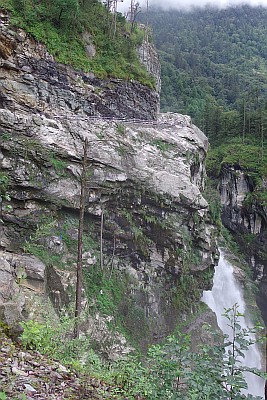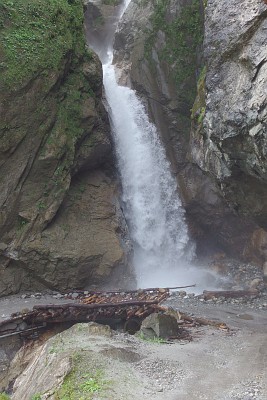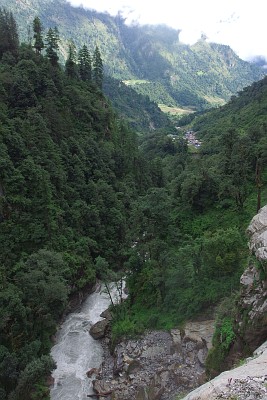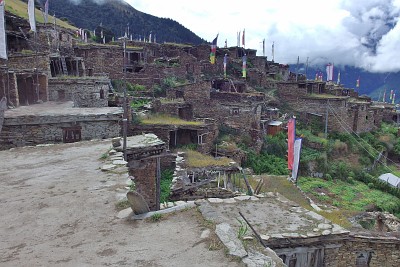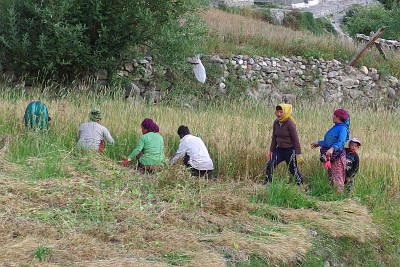From Dharapani to Manang
(vero;2017-Feb-28)
There is now a dirt road all the way from Besi Sahar to Manang and we were fearing the worst when we arrived in Dharapani. But the road is hardly used and the few jeeps which ply it are seldom enough not to spoil the trek. Anyway, there are many occasions to leave the dirt road and follow a re-routed path marked with red/white signalling (reminiscent of French GR markings). We sticked mostly to the road until Dhukur-Pokhari where we took the scenic Upper Route to Upper Pisang and Braga.
From Dharapani to Manang (4 days, 19 Sept 2016 to 22 Sept 2016)
- 19 Sept: Dharapani(1960m) to Koto (2620m)
- 20 Sept: Koto (2620m) to Upper Pisang (3310m)
- 21-22 Sept: Upper Pisang (3310m) to Braga (3450m) - Rest day visiting Braga and Manang (3540m)
19 Sept: Dharapani(1960m) to Koto (2620m)
We finish our Manaslu trek in Dharapani. We register at the check post as soon as we arrive and take leave from our guide Santosh. All this takes us about 30 minutes and in the little time we see more trekkers than we have seen in 16 days around Manaslu. Jeeps are waiting on the road, the lodges look quite fancy and there are shops with Snickers, Mars and other goodies. We are definitely on a different trek.
It is good to be again only the two of us and we decide to start at once. After the two last weeks and the many days spent on muddy and slippery trails, we are more than happy to stay on the dirt road and have some solid ground under our feet. There is no traffic anyway and the scenery is pleasant. The trail follows the course of the Marsyangdi river up to Manang and on this portion of the trek between Dharapani and Danakyu the river has cut a deep and narrow gorge. The trail and the road climb accordingly.
At one point we take the re-routed trail to avoid some hairpin curves and as we meet the road again we continue on the trail on the other side: big mistake! We fail to notice that the signalling on the rock is faded and end-up on an old slimy trail which disappears sometimes between fallen trees and bushes. We have to skirt big puddles and our steps are weighed down by the mud under our shoes. It is worse than all we had experienced on Manaslu! We wonder whether we are on the right route and are relieved to rejoin the road just before Danakyu. No need to say that we stick to the road for the rest of the day; the views are good and we enjoy the walking very much. We arrive in Koto where we decide to stop for the night in a nice lodge with views on Annapurna 2. 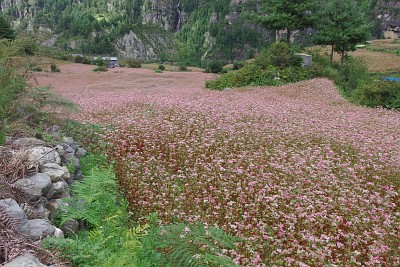
The lodge gets busy as a lorry stops in front of the garden and some guides and porters disembark and start to unload an impressive amount of gear and food for an upcoming Himlung expedition. Most of it will be eventually loaded on 40 mules and taken to the Himlung base camp. The expedition comprises 13 German climbers who will arrive tomorrow. In the mean time the porters sort the gear and take their quarters in a building cum kitchen located in the back garden. This garden is full of apple trees, all bearing ripe fruits and our hostess makes sure to pick and stock as many as possible before the guests raid her trees. She gives us some to taste and they are delicious.
The lodge is pleasant. Two kitchen girls from Chitwan, 12 and 15 years old, are catering for the well-being of the guests and there is a cheery ambiance: much laughter and small dances.
A group of trekkers arrives towards the end of the afternoon: they have guide and porters and are on their way to the Nar Phu Trek. Although they sleep in the lodge their meals are cooked by their own crew and we don't see much of them.
20 Sept: Koto (2620m) to Upper Pisang (3310m)
Jubilation as we wake up: we open the curtains and can see Annapurna 2 in its whole splendour in front of us. But the clouds arrive and it has disappeared by 8 am. The weather is nevertheless good and we stick to the road for most of the day. Apples are the big thing here: there are many orchards around Bhrathang, all secured behind high fences (Boards warn us: No Trespassing, 5000 Rs fine!) and a big building (farm? distillery? warehouse?) is being erected along the road.
We make a long lunch break in Dhukur-Pokhari and enjoy the warm sunshine. What a difference to Manaslu! The path to Upper Pisang branches from the main road after this village and we arrive there earlier than expected. We see wild apricot trees along the way; some of the fruits are a bit bitter but we eat plenty of them. After a good hot shower in Upper Pisang, we go and explore the village which has not changed very much since we last visited in 2001. There are now three big lodges but they are not disruptive and the old stone houses are still there albeit many seem now inhabited. A new gompa has been built but we see no monks around. Strange.
We spend a pleasant evening in our lodge with a couple from Norway and a German trekker. We are not alone on the trek anymore and we are walking in parallel with around 30 other trekkers whom we keep seeing during the day and sometimes meet again in the evening. Most pleasant and notable are two Israeli young women cum porter, a group of five Israeli young men and Sophia, a German girl. We will keep bouncing into them or sharing lodges until Muktinath and really enjoyed their company.
21-22 Sept: Upper Pisang (3310m) to Braga (3450m) - Rest day visiting Braga and Manang (3540m)
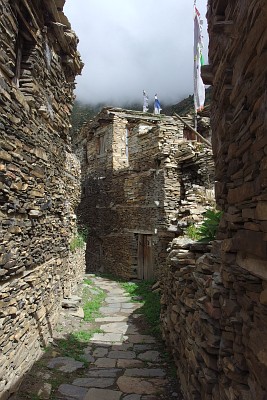 The section of the Annapurna Circuit between Upper Pisang and Manang is one of the highlights of the trek and we have a photo gallery dedicated to it.
The section of the Annapurna Circuit between Upper Pisang and Manang is one of the highlights of the trek and we have a photo gallery dedicated to it.
The so-called Upper Route provides great panoramic views on the valley and goes through picturesque old villages with plenty of typical stone houses, mani walls and prayer flags. It's just too bad that the cloud cover hides the mountain summits. Compared to what we have seen around Manaslu, the houses are bigger and not attached to each other: most have a small garden and an inner courtyard. People here are wealthier: the area is good for cultivation and they have been benefiting from trade for centuries. It is a steep climb to Gyaru where we make a long break before continuing to Ngawal. The path skirts the mountain without losing height then descends to Julu before rejoining the road in the valley.
We decide to stay in Braga; there are four fancy lodges along the trail and everybody seems to follow a kind of herd instinct and ends up at the first one. We stay in the last one (Himalayan Lodge) for two nights where we are the only guests.
Our host is a friendly man and we spend a nice evening talking with him. He has been in business for a long time and has lived through many changes. But life is hard and we can feel with him. Like us, he regrets “the good old days” when trekkers were easy going, not so fussy as today and happy with a simple dhal bhat and a smoky stove to keep warm. Going to the loo in the cold in the back garden was not a problem and no one complained about the thin mattress in the dorm or basic rooms.
Times are different now: tourists expect hot showers, single rooms with more or less clean sheets, inside toilets, attached bathrooms (!), electricity sockets and wifi, you name it, they have to have it. Think about the foolishness of western toilets (which are in high demand nowadays) in an environment where running water is not a matter of fact and where squat toilets are much more hygienic. But he had to install those; they are prone to blockages, need constant repair and are more worry than anything. As a lodge owner, he has to keep up to stay in business. That means investing, modernising, repairing and costs a lot of money and produces additional stress.
He is also nostalgic of the interaction he used to have with his old customers: most of them came without porter or guide, their wishes were easy to fulfil and he had time to speak with them. Now they are shielded by their guide/porters who speak or order food for them and people are not so communicative as before. He has become an hotelier and is not a host anymore.
We totally agree with him. This is a development which we have also witnessed in the course of our many visits. This is why, when possible, we always look for smaller and basic family run lodges because they are not so crowded and we can interact with the locals. Those lodges are unfortunately threatened to disappear. They simply cannot compete against the big lodges, many of them now managed by lessees, while their owners are living in Kathmandu or even abroad. These lessees are often strangers to the area and just here to make money. They have no reason or desire to interact with their customers: it is business and nothing else.
We have a rest day and feel very lazy: no trip to the Milarepa cave or the Ice Lake for us. We spend time exploring Old Braga and go to Manang for a stroll around the old village lanes. As in Sama, the people of Manang have luckily managed to keep their old village separated from the new lodge settlement with the shops and cafés which have mushroomed around them. There are many big lodges and the shops offer all the same stuff; it feels like a “Namche Bazaar in the making”.
Old Manang is interesting. The locals are busy harvesting hay. We see them returning from the fields and carrying large stacks of hay which they disperse on the roofs of their houses for drying.
Our host in Braga has some fields around the village and has hired some labourers for the harvest: in addition to pay, they also get free cost and in the evening they come with their family for dinner, which means that the evening is lively and interesting and we do not miss the company of other trekkers.
Check our photo gallery for pictures of the Upper Route and Manang.
Go back to Around Annapurna or go on to Side Trip to Tilicho Lake
$ updated from: Around Annapurna.htxt Mon 28 Apr 2025 14:55:29 trvl2 — Copyright © 2025 Vero and Thomas Lauer unless otherwise stated | All rights reserved $




